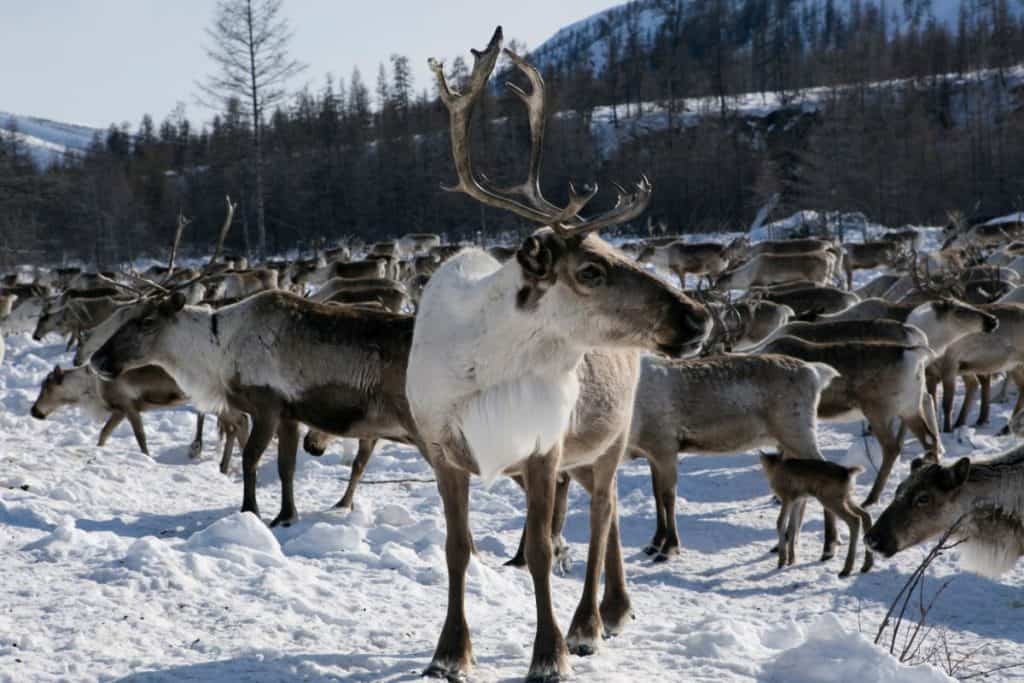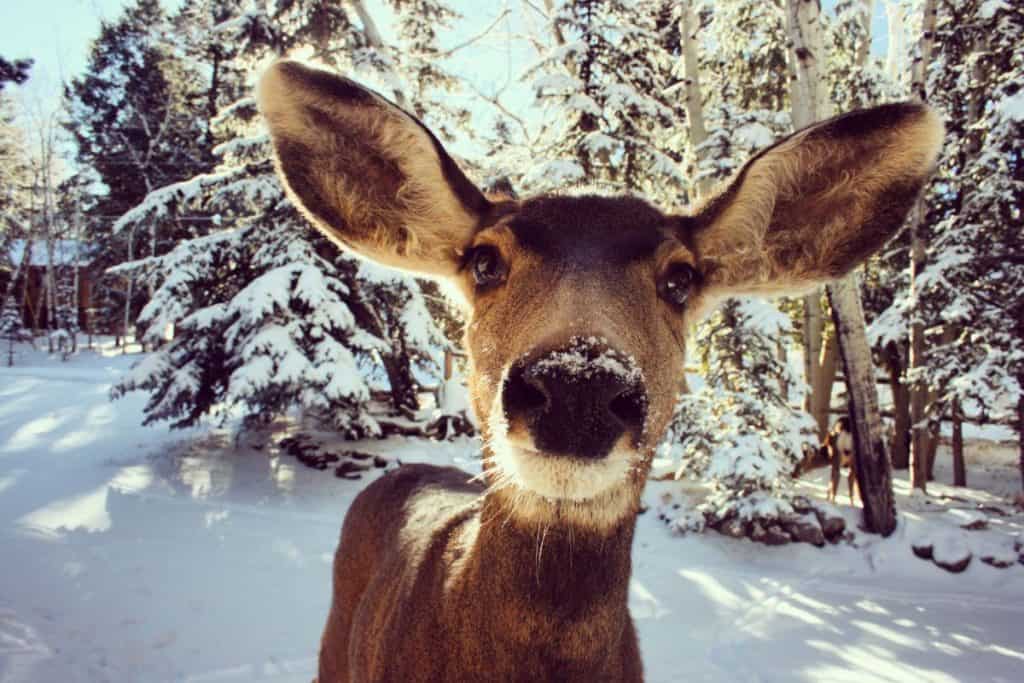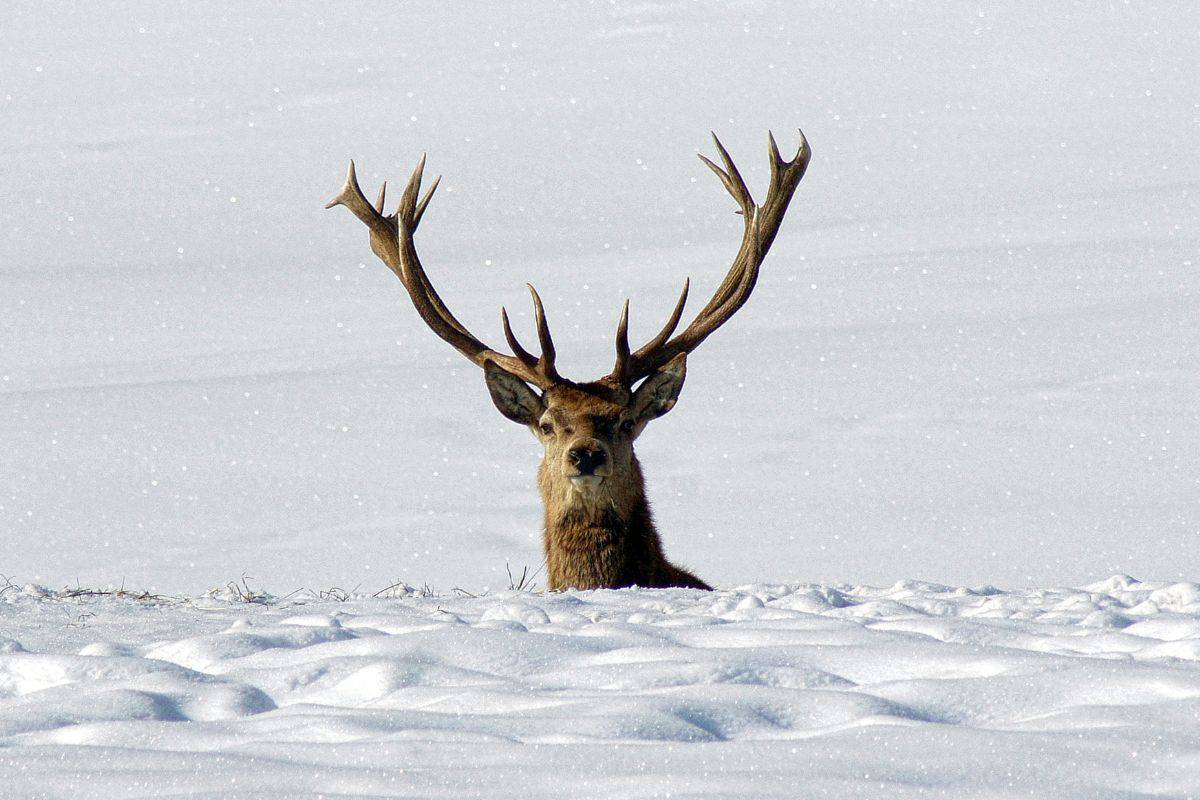Winter, particularly in Northern Hemisphere habitats, can be harsh and brutal. Deep snow, biting winds, and long cold nights make it challenging for any animal to stay warm and survive. So how do deer stay warm in the winter? Especially when they are continually exposed to the elements day and night?
Well, they manage to not only survive the winter, but some species thrive in many cases. And they manage it by taking advantage of natural adaptations and changing their behaviors to stay warm in some of the most extreme conditions.
So, let’s take a look at how deer stay warm in the winter.
How Do Deer Stay Warm During the Winter Months?
Deer stay warm during the harsh winter months through several natural adaptions and behavioral changes. Behavioral strategies include eating more food, reducing movement, and spending more time in sheltered areas. Deer also benefit from several physical characteristics that help them stay warm, including thicker winter coats and temperature-regulating noses.
So let’s look in more detail at how deer stay warm through a combination of natural adaptions and behavioral changes, starting with their natural adaptations.

Natural Adaptations That Keep Deer Warm in the Winter
Deer Stay Warm in Winter with Thicker Fur Coats
The winter coat deer grow is by far the most critical factor in how deer stay warm in the winter. As the colder seasons approach, a deer’s coat will initially shed before growing back thicker, longer, and darker hairs (known as guard hairs) to provide insulation against the cold.
The coat comprises two types of hair – the long outer guard hairs mentioned above and the shorter underfur. The guard hairs are hollow, which helps to trap heat from sunlight and maintain body temperature, while the underfur is soft and dense, providing an additional layer of warmth.
Deer Produce Oil from Skin Glands
Another natural adaptation of deer that helps them to see off the worst the winter can throw at them is the oil secreted from glands within their skin. During the winter, deer produce oil from these glands, which waterproofs their fur coat.
This is particularly important in colder, wetter conditions where rain, snow, ice, and biting winds can penetrate the coat and lead to a loss of body heat. The oil produced from these skin glands also helps to keep the coat water repellent and prevents it from matting down, which would significantly reduce its ability to trap air and insulate.
Noses Help Regulate Body Temperature in Deer
While you might not have thought a deer’s nose helps to see it through winter, it actually plays a vital role in how deer stay warm. The nose of a deer is packed full of small blood vessels (which is where the “red nose” reindeer comes from), with a 25% greater density than in humans.
The highly-vascularized deer nose helps to keep vital organs such as the brain at the right temperature by effectively working as an internal heat exchange system.
Basically, each breath taken from the nose is warmed on its way to the vital organs, such as the lungs and brain, before being cooled during exhalation. The air is cooled on its way out to condense it into water vapor, helping deer retain moisture in the mucus membranes around their facial area.

Utilize Internal Body Temperature Controls
Deer are endothermic, like us, meaning they create almost all of their heat internally. While they do use their enhanced winter coat to absorb heat from sunlight, most of their heat is generated from within.
However, one natural adaptation deer have that humans don’t is the ability to regulate heat within specific areas of their body. For instance, it’s pretty common for deer to “steal” internal heat from their legs and send it to vital organs such as the heart, lungs, and brain to ensure these systems are kept at optimum temperatures.
In addition to their natural adaptations, deer also pick up several new behaviors to help them stay warm in winter.
Behavioral Changes That Help Deer Stay Warm During the Winter
Deer Change Their Dietary Habits to Fatten Up for Winter
One of the most noticeable changes to deer behavior during the winter is that they spend more time foraging for food.
Once the temperature begins to drop, deer tend to increase their calorie intake, increasing their consumption of usual staples such as twigs, stems, grasses, and other plant life. However, deer will also supplement their diet with high-calorie foods such as nuts, fruits, and even the occasional mushroom to build up their fat reserves.
Internal fat reserves tend to initially build up around the vital organs before developing insulating layers of subcutaneous fat beneath the skin. This helps to protect deer from extreme cold and provides a valuable energy source that can be used during periods of resting and sheltering.
Deer Reduce Movement to Save Energy and Maintain Warmth
In the depths of winter, deer will often hunker down for long periods to conserve energy. By reducing their movement, they can lower their metabolic rate and reduce the amount of heat their bodies need to generate. Deer can reduce their metabolism by as much as 50% during winter, which significantly saves energy consumption.
Deer can often lay down and shelter for days on end, helping them see out weather phenomena such as blizzards and ice storms. This is made possible by the fat reserves they have built up and the slow-release energy provided by these reserves.
Deer Seek Sheltered Spots to Stay Warm in Winter
Deer will also spend more time sheltering in thickets or beneath trees to escape the worst of the weather. They have been known to seek out coniferous trees (such as fir, spruce, and pine), as their needles can often collect snow and provide some cover and shelter from the wind.
Forests like these can turn into so-called “deer yards,” where dozens of deer will spend the winter months. By staying close together, they can share body heat and help each other stay warm in winter.

Final Thoughts on Deer Staying Warm in Winter
Deer are incredibly resilient creatures and survive cold winters in a variety of ways. By changing their diet and behavior and harnessing their many natural adaptations (such as growing thicker winter fur coats), deer are able to stay warm throughout the winter months.
So, the next time you see a deer out in the snow, just remember how specially adapted they’ve become to survive in some of the harshest winter conditions!

